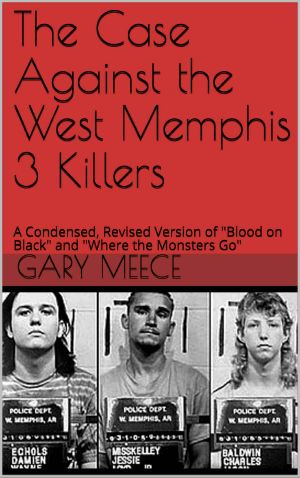The Case Against the West Memphis 3 Killers · A Condensed, Revised Version of "Blood on Black" and "Where the Monsters Go"

- Authors
- Meece, Gary
- Publisher
- UNKNOWN
- Date
- 2017-03-26T00:00:00+00:00
- Size
- 0.33 MB
- Lang
- en
They did it.
The West Memphis 3 are guilty. They are guilty despite what the documentaries, books and news stories have said over and over.
Guilty beyond a reasonable doubt.
Damien Echols, Jason Baldwin and Jessie Misskelley Jr. killed three 8-year-olds, Christopher Byers, Michael Moore and Stevie Branch, on May 5, 1993, in a wooded area in West Memphis, Ark.
The murders were thrill kills, according to Echols himself. But they were much more than that. Police were struck by the ritualistic aspects. Local dabblers in the occult immediately came under suspicion.
Under questioning, Echols, already acknowledged as a witch, flaunted his knowledge of the occult, his theories of how the killings could have “magickal” implications and his insights into how the killer would think and feel. He demonstrated special knowledge about the case beyond the little publicly known. He gave out signals that he was a prime suspect; a series of witnesses further implicated him.
A confession broke open the case.
The widely accepted WM3 storyline is that inept police and prosecutors, with a howling mob of religious fanatics to placate, somewhat arbitrarily picked out three innocent boys to blame for horrific murders because Damien and his best pal Jason wore black T-shirts, listened to heavy metal music and had funny haircuts and because the third boy, Little Jessie, was practically retarded and thus easily manipulated.
Almost every element in that storyline has little relation to reality.
The weirdness that drew the attention of authorities stemmed from bad choices by the suspects rather than clothing, haircuts or rocking out to Megadeth.
The West Memphis police did their duty in a diligent if imperfect manner. The investigation was professional and painstaking. Detectives took many statements, followed strange and unpromising leads and administered the polygraph dozens of times.
All three of the teens from the trailer parks were convicted. The convictions held up on appeal.
Eventually, thanks to Hollywood celebrities and misleading documentaries that left out crucial evidence, the killers who became the West Memphis 3 walked free.
No exonerating evidence, despite many years of investigation and a defense fund in the millions of dollars, has been produced. None of the three has a credible alibi.
The mainstream media bought into the premise that “those boys were innocent.”
By putting the focus on mullet-headed rednecks, drawling overweight cops and righteously angry Christians, the media played upon the most egregious stereotypes of Southern whites, while positioning a murdering sociopath as a hip kid who was just too cool for the uptight hometown idiots. The West Memphis 3 myth was made to order for the familiar narrative of the perceptive young outsider that every hipster and aspiring artist imagines himself to have been. Among the sensitive souls who found a doppelgänger of their teen selves in Echols were professional outsiders — such as Johnny Depp and Henry Rollins.
In Aleister Crowley’s “magickal” system, which Echols embraced in his preteen years, orgasm and ecstasy are equated with death and sacrifice and the sexual fluids are often represented as blood or water.
Echols felt he was in transition to a state of being a god, something other than human; he believed that drinking blood invested him with spiritual energy.
Echols and “blood brother” Jason formed a pathological dyad, cultivating elaborate violent fantasies.
Via the ritual torture, killing and eating of dogs, cats and other animals, they educated themselves in the curriculum of occult murder.